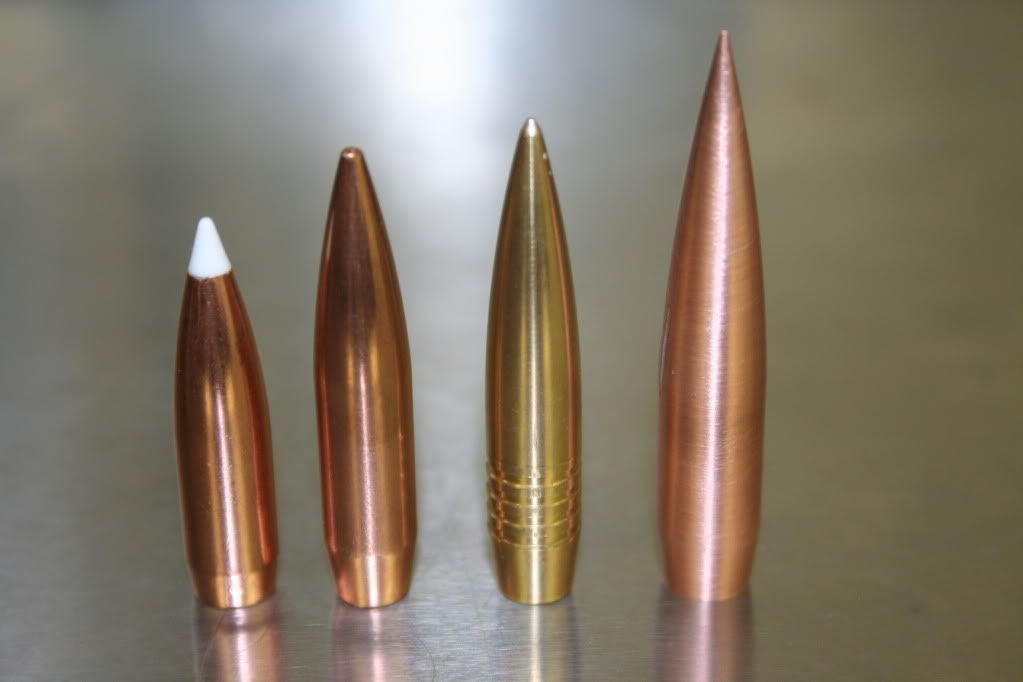Can someone shed some light on this topic?
My ballistics program tells me the following BC's for each of the commercial bullets I've worked with.
.805 300gr Lapua Scenar
.755 300gr Sierra Match King
.675 250gr Sierra Match King
.662 250gr Lapua Scenar
Now here's the question(s)...
I've been looking at "solids" over the last few months and want to give them a try. I've seen some shops that claim a BC on their .338 CNC Lathed bullets of 1.010 some higher some lower!!
http://www.gsgroup.co.za/sptech.html
http://www.predatorprojectiles.com.au/html/projectiles.html
http://www.rmbullets.com/page6.html
http://www.xtrememachining.biz/products_338xtreme.html
What would any of you experienced larger bore, long range shooters out there with experience shooting solids, say I should expect with my experimentation?
I realize the bullets are harder on my barrel and possibly some copper fouling to stay on top of, but what else? I’m told I have to push’em faster too. From 3100fps to 3400fps. (I loose accuracy with the commercial bullets if I push’em past 3000fps, I’ve already established that with my rifle/chronograph).
Do these kinds of bullets fly better? Fly flatter/straighter? Faster? More energy? Have more penetrating ability at further distances?
I've been able to punch through 5/8 steel at 500 yards with a 250gr Lapua FMJBT, but it wouldn't do it at 550 yards. Would the solids do better penetrating that sort of material at further distances?
Is it worth the extra money and barrel wear to shoot solids? Is the accuracy really that much more noticeable?
My ballistics program tells me the following BC's for each of the commercial bullets I've worked with.
.805 300gr Lapua Scenar
.755 300gr Sierra Match King
.675 250gr Sierra Match King
.662 250gr Lapua Scenar
Now here's the question(s)...
I've been looking at "solids" over the last few months and want to give them a try. I've seen some shops that claim a BC on their .338 CNC Lathed bullets of 1.010 some higher some lower!!
http://www.gsgroup.co.za/sptech.html
http://www.predatorprojectiles.com.au/html/projectiles.html
http://www.rmbullets.com/page6.html
http://www.xtrememachining.biz/products_338xtreme.html
What would any of you experienced larger bore, long range shooters out there with experience shooting solids, say I should expect with my experimentation?
I realize the bullets are harder on my barrel and possibly some copper fouling to stay on top of, but what else? I’m told I have to push’em faster too. From 3100fps to 3400fps. (I loose accuracy with the commercial bullets if I push’em past 3000fps, I’ve already established that with my rifle/chronograph).
Do these kinds of bullets fly better? Fly flatter/straighter? Faster? More energy? Have more penetrating ability at further distances?
I've been able to punch through 5/8 steel at 500 yards with a 250gr Lapua FMJBT, but it wouldn't do it at 550 yards. Would the solids do better penetrating that sort of material at further distances?
Is it worth the extra money and barrel wear to shoot solids? Is the accuracy really that much more noticeable?



